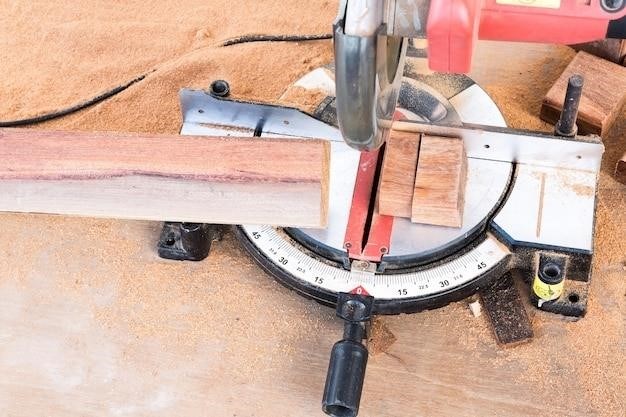Router Straight Edge Guide⁚ A Woodworker’s Essential Tool
A router straight edge guide is a tool used in woodworking to help make straight and accurate cuts with your router. Think of it like the fence on a table saw—it basically keeps the router on track. This tool helps ensure your cuts are neat and precise, whether making edges smooth, cutting grooves, or carving out specific shapes.
Introduction
In the realm of woodworking, precision is paramount. Whether you’re a seasoned craftsman or a novice enthusiast, achieving clean, accurate cuts is essential for creating beautiful and functional pieces. While a router is a versatile tool for shaping and trimming wood, it can be challenging to maintain a straight path, especially for long cuts. This is where a router straight edge guide comes into play.
This invaluable tool acts as a guiding force for your router, ensuring that every cut is executed with unwavering accuracy. By providing a stable and consistent reference point, the router straight edge guide eliminates the guesswork and potential for human error, allowing you to achieve professional-looking results with ease.
Whether you’re creating intricate moldings, trimming edges, or cutting precise grooves, a router straight edge guide is an indispensable asset in your woodworking arsenal. This article will delve into the world of router straight edge guides, exploring their benefits, types, and how to effectively utilize them for a variety of woodworking projects.
What is a Router Straight Edge Guide?
A router straight edge guide is a specialized tool designed to enhance the accuracy and precision of routing operations. It essentially acts as a fence or rail that guides the router along a straight path, ensuring that the cut is consistent and true. Unlike a table saw, which uses a stationary fence to guide the workpiece, a router straight edge guide attaches to the router base and moves with it, providing a dynamic guide for the cutting bit.
The guide consists of a rigid, straight edge that runs parallel to the router bit. This edge can be made from various materials, such as metal, plastic, or wood. The guide is typically attached to the router base plate using clamps or screws, allowing for adjustable positioning. The guide’s edge acts as a reference point for the router, ensuring that the bit follows a straight path.
Essentially, the router straight edge guide transforms your router into a portable straight-edge cutting system, making it possible to achieve clean, precise cuts on large or oddly shaped workpieces where a table saw might not be practical.

Benefits of Using a Router Straight Edge Guide
The use of a router straight edge guide brings a multitude of advantages to woodworking projects, making it a valuable tool for both novice and experienced craftspeople. The primary benefit is the enhanced accuracy and precision it provides. With a guide in place, the router bit is constrained to follow a straight path, eliminating the risk of wandering or drifting, which can lead to uneven cuts and compromised results. This consistency is especially crucial when working with delicate materials or intricate designs.
Another notable advantage is the ease of use and control. The guide simplifies the routing process by eliminating the need for constant hand guidance, allowing the woodworker to focus on maintaining the desired depth and speed of the cut. This enhanced control contributes to a smoother, more efficient workflow, reducing the likelihood of errors or mishaps. Furthermore, the guide enables precise cuts on large or awkward-shaped workpieces that might be challenging to handle on a table saw;
Beyond these core benefits, a router straight edge guide offers versatility and adaptability. It can be used for a wide range of applications, from basic edge trimming to more complex tasks like grooving and rabbeting. This versatility makes it a valuable addition to any woodworker’s toolkit, expanding the possibilities for creative projects and precise craftsmanship.
Types of Router Straight Edge Guides
The world of router straight edge guides offers a spectrum of options to suit different needs and budgets. The most common types fall into two main categories⁚ dedicated router edge guides and DIY router edge guides. Dedicated router edge guides are specifically designed for use with routers and often come with features tailored for precision and ease of use. These guides can be found in various materials, such as metal, plastic, or wood, and may include adjustable fences, dust collection ports, and other handy features. They are typically sold by major tool manufacturers and often come with detailed instructions for setup and usage.
On the other hand, DIY router edge guides offer a cost-effective and customizable approach. These guides can be crafted from readily available materials like wood, metal, or even hardboard. The advantage of DIY guides lies in their adaptability; they can be tailored to specific project requirements and often require minimal tools and expertise. This approach allows woodworkers to create bespoke guides that perfectly suit their individual needs and preferences. However, it’s important to note that DIY guides may require a bit more effort in terms of construction and accuracy compared to dedicated guides.
Ultimately, the choice between dedicated and DIY router edge guides depends on individual preferences, project requirements, and budget constraints. Both options offer a valuable tool for achieving straight and precise cuts with a router.
Dedicated Router Edge Guides
Dedicated router edge guides represent a highly specialized category of tools designed to work seamlessly with routers. These guides are manufactured by prominent tool companies like Bosch and Ryobi, offering pre-engineered solutions for precise and efficient routing. They often come equipped with a variety of features that enhance their functionality and user experience. These features may include adjustable fences for precise edge control, dust collection ports for improved workspace cleanliness, and mounting systems that ensure secure attachment to the router.
One notable example is the Bosch Deluxe Router Edge Guide (RA1054), which enhances the versatility of Bosch routers. It enables edge-forming using non-piloted bits and guides cuts along the workpiece edge or up to 8 inches from the edge. Another popular option is the Ryobi 6090080 straight edge guide, crafted from sturdy steel and finished with a sleek black polish. It includes guide rods for effective handling of Ryobi routers, with the guides positioned 3 1/4 inches from the center. These dedicated guides provide woodworkers with a reliable and efficient approach to achieving straight and accurate cuts with their routers, offering convenience and precision tailored to their specific needs.
DIY Router Edge Guides
For the resourceful woodworker, the realm of DIY router edge guides offers a rewarding path to crafting custom solutions tailored to specific needs. These guides can be constructed from readily available materials like wood, metal, or even plastic, providing a cost-effective and personalized approach to achieving precise routing. The simplicity of their design allows for easy adaptation to various router models and projects.
One popular DIY approach involves using a straight piece of hardwood as the guiding fence. This fence is then secured to the router base using clamps, screws, or other suitable fastening methods. Alternatively, a wooden jig can be built using a simple design that incorporates a straight edge, a support base, and a means of attaching the router. These DIY guides often require some experimentation to achieve optimal alignment and stability, but they offer a satisfying sense of accomplishment and the flexibility to adapt to specific routing tasks. Whether crafted from scrap wood or carefully engineered using precise measurements, DIY router edge guides provide a testament to the ingenuity and resourcefulness of woodworkers.
Choosing the Right Router Straight Edge Guide
Selecting the ideal router straight edge guide involves considering various factors that align with your specific needs and woodworking projects. The first crucial factor is compatibility with your router model. Ensure the guide seamlessly attaches to your router base, whether through a universal design or model-specific fittings.
Next, assess the guide’s construction materials. Sturdy metal guides offer excellent durability and precision, while plastic options provide lightweight portability. Consider the intended applications; for demanding projects, metal guides are often preferred for their robustness. The guide’s design should also suit your routing tasks. Straight edge guides are best for linear cuts, while adjustable models allow for varying distances from the edge. Finally, factor in your budget and the frequency of use. A dedicated guide may be a worthwhile investment for frequent use, while DIY options cater to occasional projects.
Using a Router Straight Edge Guide
Using a router straight edge guide is relatively straightforward, but there are a few key steps to ensure accuracy and safety. First, secure the guide to your router base, ensuring it’s firmly attached and aligned with your router bit. Carefully position the guide along the edge of your workpiece, ensuring it’s parallel and flush with the material. Use clamps or other securing methods to hold the guide in place, preventing movement during the routing process.
Next, set the depth of cut on your router, considering the desired depth for your project. Start with a shallow cut to minimize the risk of tear-out or damage to the workpiece. Begin the cut slowly, ensuring a smooth and even motion. Apply consistent pressure on the guide as you move the router, maintaining a steady pace to achieve a clean, precise edge. Remember to always follow safety precautions and wear appropriate eye protection while using a router and its accessories.
Setting up the Guide
Setting up your router straight edge guide involves ensuring it’s properly mounted on your router and aligned with your bit. Start by carefully attaching the guide to the base of your router. Most guides have a mechanism for secure attachment, whether it’s screws, clamps, or a quick-release system. Ensure the guide is firmly in place, as any movement during routing can lead to inaccurate cuts.
Next, align the guide with your router bit. This is crucial for achieving straight, precise cuts. Some guides have adjustable features allowing for precise positioning, while others may require you to mark and adjust the guide manually. Take the time to carefully align the guide to your desired distance from the edge of the workpiece, ensuring it’s parallel and perpendicular to the material.
Once the guide is secured and aligned, double-check that it’s stable and won’t shift during use. It’s often a good idea to test the guide with a scrap piece of wood to ensure it’s functioning correctly before proceeding with your project.
Making the Cut
With the guide securely attached and aligned, you’re ready to make your cut. Begin by positioning the workpiece against the guide, ensuring it’s firmly in place. Start the router slowly, allowing the bit to engage with the wood. Maintain a steady and consistent pressure on the router, keeping it moving smoothly along the guide.
Avoid pressing too hard, as this can cause the router to bind or deviate from the guide. Conversely, too little pressure can result in inconsistent depth of cut. A light, even pressure is key to achieving smooth, precise cuts.
As you move the router along the guide, keep a close eye on the cut. If you notice any deviation, immediately stop the router and readjust the guide. With practice, you’ll develop a feel for the router and the guide, allowing you to make clean, accurate cuts with ease.
Safety Precautions

Using a router straight edge guide requires a level of caution to ensure your safety. Always wear safety glasses to protect your eyes from flying debris. Hearing protection is also recommended, as the router can generate significant noise. Always unplug the router when adjusting the guide, making changes, or cleaning up.
When working with the router, avoid loose clothing or jewelry, as these can get caught in the router’s moving parts. Work in a well-ventilated area, as dust from the router can be hazardous; It’s crucial to keep your fingers clear of the router bit and the guide, as even a slight slip can result in a serious injury.
Before starting a cut, ensure the guide is securely fastened and the workpiece is firmly clamped in place. If you encounter any problems or feel uncomfortable, stop the router and address the issue before proceeding. Always prioritize safety and follow the manufacturer’s instructions for your router and guide.
Applications of Router Straight Edge Guides
Router straight edge guides are incredibly versatile tools that can be used for a wide range of woodworking tasks, enhancing both precision and efficiency. One common application is edge trimming, where the guide helps create clean, straight edges on boards or panels. This is particularly useful for preparing materials for joinery or creating a finished look.
Another key application is grooving, which involves cutting a channel or recess into the surface of a workpiece. Router straight edge guides make it easy to create consistent and accurate grooves for various purposes, such as installing drawer slides, creating decorative details, or housing electrical wiring.
Rabbetting is another woodworking technique that benefits from the use of a router straight edge guide. This involves cutting a rectangular recess along the edge of a board, often used to create a dado joint or to accommodate a panel. The guide ensures the rabbet is straight and consistent, essential for achieving strong and precise joints.
Edge Trimming
Edge trimming is one of the most common applications for a router straight edge guide. It involves using the guide to create a clean, straight edge along the length of a board or panel. This is a crucial step in woodworking for several reasons; Firstly, it ensures that the edge is smooth and free of any imperfections, improving the overall aesthetic appeal of the finished piece. Secondly, a precise edge is essential for creating strong and accurate joints, whether you’re making a dado joint, a rabbet, or simply joining two pieces of wood together.
The router straight edge guide acts as a fence, guiding the router along the edge of the workpiece and preventing any deviation from the desired path. This eliminates the need for hand-guided cuts, which can be prone to errors, especially when dealing with long or intricate pieces. The result is a perfectly straight edge, ready for further processing or assembly.
Grooving
Grooving with a router straight edge guide is a versatile technique used to create recesses or channels in wood. This can be done for various purposes, such as creating a decorative detail, housing a wire or cable, or creating a tongue-and-groove joint for joining panels together. With the guide in place, the router can precisely follow the desired path, ensuring that the groove is straight, consistent, and runs the full length of the workpiece.
The depth and width of the groove are determined by the chosen router bit and the settings on the router itself. You can use different bit profiles to create grooves of varying shapes and sizes, depending on the desired outcome. The router straight edge guide helps you achieve the desired groove with accuracy and ease, making it a valuable tool for creating both functional and decorative elements in your woodworking projects.


















